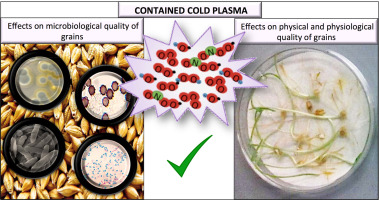Food Research International ( IF 7.0 ) Pub Date : 2018-01-09 , DOI: 10.1016/j.foodres.2018.01.009 Agata Los , Dana Ziuzina , Simen Akkermans , Daniela Boehm , Patrick J. Cullen , Jan Van Impe , Paula Bourke

|
Contamination of cereal grains as a key global food resource with insects or microorganisms is a persistent concern for the grain industry due to irreversible damage to quality and safety characteristics and economic losses. Atmospheric cold plasma presents an alternative to conventional grain decontamination methods owing to the high antimicrobial potential of reactive species generated during the treatment, but effects against product specific microflora are required to understand how to optimally develop this approach for grains. This work investigated the influence of ACP processing parameters for both cereal grain decontamination and grain quality as important criteria for grain or seed use. A high voltage (HV) (80 kV) dielectric barrier discharge (DBD) closed system was used to assess the potential for control of native microflora and pathogenic bacterial and fungal challenge microorganisms, in tandem with effects on grain functional properties. Response surface modelling of experimental data probed the key factors in relation to microbial control and seed germination promotion. The maximal reductions of barley background microbiota were 2.4 and 2.1 log10 CFU/g and of wheat - 1.5 and 2.5 log10 CFU/g for bacteria and fungi, respectively, which required direct treatment for 20 min followed by a 24 h sealed post-treatment retention time. In the case of challenge organisms inoculated on barley grains, the highest resistance was observed for Bacillus atrophaeus endospores, which, regardless of retention time, were maximally reduced by 2.4 log10 CFU/g after 20 min of direct treatment. The efficacy of the plasma treatment against selected microorganisms decreased in the following order: E. coli > P. verrucosum (spores) > B. atrophaeus (vegetative cells) > B. atrophaeus (endospores). The challenge microorganisms were more susceptible to ACP treatment than naturally present background microbiota. No major effect of short term plasma treatment on the retention of quality parameters was observed. Germination percentage measured after 7 days cultivation was similar for samples treated for up to 5 min, but this was decreased after 20 min of direct treatment. Overall, ACP proved effective for cereal grain decontamination, but it is noted that the diverse native micro-flora may pose greater resistance to the closed, surface decontamination approach than the individual fungal or bacterial challenges, which warrants investigation of grain microbiome responses to ACP.
中文翻译:

通过高压常压冷等离子体封闭处理提高小麦和大麦的微生物安全性和品质特性
由于对谷物的质量和安全特性造成不可逆转的破坏,以及经济损失,谷物作为一种重要的全球食品资源受到昆虫或微生物的污染一直是谷物行业关注的问题。大气冷等离子体由于在处理过程中产生的反应性物种具有很高的抗菌潜力,因此是常规谷物去污方法的替代方法,但是需要了解针对特定产品菌群的影响,以了解如何最佳地开发这种谷物处理方法。这项工作调查了ACP加工参数对谷物去污和谷物品质的影响,这些因素是谷物或种子使用的重要标准。高压(HV)(80 kV)介电屏障放电(DBD)封闭系统用于评估控制天然微生物区系和病原细菌和真菌挑战性微生物的能力,同时影响谷物的功能特性。实验数据的响应面建模探讨了与微生物控制和种子萌发促进有关的关键因素。大麦本底微生物的最大减少量为2.4和2.1 log10 CFU / g和小麦- 细菌和真菌分别为1.5和2.5 log 10 CFU / g,需要直接处理20分钟,然后密封处理后保留24小时。对于接种在大麦谷粒上的挑战性生物,对萎缩芽孢杆菌内生孢子的耐药性最高,无论保留时间如何 ,直接处理20分钟后最大降低2.4 log 10 CFU / g。血浆处理针对所选微生物的功效按以下顺序降低:E。大肠杆菌 > P。疣状(孢子)> 乙。萎缩性(营养细胞)> 乙。萎缩症(内生孢子)。攻击微生物比天然存在的背景微生物对ACP处理更敏感。没有观察到短期血浆处理对保留质量参数的重大影响。培养长达5分钟的样品在培养7天后测得的发芽率相似,但是直接处理20分钟后,发芽率却降低了。总体而言,ACP被证明对谷物谷物的去污有效,但要注意的是,与单独的真菌或细菌挑战相比,多样化的天然微生物区系对封闭的表面去污方法可能具有更大的抵抗力,因此有必要对谷物微生物组对ACP的反应进行研究。











































 京公网安备 11010802027423号
京公网安备 11010802027423号